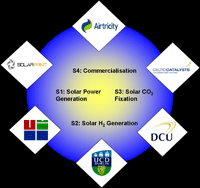Research Programme
The Sun is our primary source of energy. The total radiant energy arriving at the Earth’s surface is enough to provide over 1000 times the energy required to supply the world’s population with all of its domestic, transport and industrial needs. Harvesting just 0.1 % of this renewable energy and converting it to electric power and stored chemical energy would therefore assist in resolving a key question of this and future centuries: when fossil fuels run out, which energy resource can we turn to?
A number of renewable energy platforms currently exist which indirectly tap into solar energy, notably wind-power and bio-fuels. Another approach, and the one favoured in this research, is to efficiently mimic the processes arising in natural photosynthesis. Included in this work is the development of new solar cell materials for electric-power generation, splitting water into hydrogen and oxygen, and capturing CO2 and converting it to fuels.
The work-programme is subdivided into four Strands with tasks which parallel the sequence of steps observed in photosynthesis.
Strands S1-S3 focus on the fabrication/characterisation of energy related materials in three major complementary areas. The objectives of Strand S4 focus on the development of commercially viable solar-energy modules.” noting the hyphen in “solar-energy modules”. These Strands are:
-
S1: Photo-responsive solar cell materials for power generation
Dye Sensitised Solar Cells (DSSCs) - novel materials
Novel materials for heterojunction Photovoltaic (PV) cells
-
S2: Catalytic materials for hydrogen production via photolysis
Development of a photoelectrochemical (PEC) cell for water splitting
-
S3: Nanoporous and catalytic materials for CO2 capture and fixation
Catalytic and photocatalytic reduction of CO2 for the production of chemical feedstocks
-
S4: Energy conversion modules
The translation of research into solar energy conversion devices and commercialisation of research

The SEC SRC includes expertise in advanced synthetic Chemistry, Biochemistry and Electrochemistry, Biophysics, Chemical and Mechanical Engineering and Design and Electronic/Electrical Engineering photonics and power generation.

A more detailed list of projects can be found in the team page, where PhDs and Postdoctoral Researchers list their project description.
Equipment & Facilities
Within the Cluster, there is significant equipment available to the team for solar conversion technology research including:
- A special purpose solar cell device and nanofabrication wet laboratory which includes tubular furnaces, dye synthesis equipment and screen printing instruments.
- Access to coating deposition equipment e.g. plasma enhanced chemical vapour deposition (PECVD), atmospheric pressure plasma liquid deposition (APPLD), magnetron sputtering (PVD), neutral atom beam bombardment, sol-gel synthesis.
- A significant computational cluster facility.
- Characterisation technologies:
- Surface morphology: Optical Microscopy, AFM and Optical profilometry.
- Coating thickness: Ball cratering device, AFM and Ellipsometer.
- Surface Energy: Contact angle.
- Surface roughness: Optical profilometer.
- Structural property: X-Ray Diffraction, BET and Pore size analysis.
- Adhesion: Scratch adhesion tester and Rockwell-C.
- Electrochemical and Spectroscopic Analytical Resources which allow for measurements for:
- Efficiency
- Bandstructure
- Structure and Topography
- Time resolved spectroscopy
Instrumentation includes:
- FEG TEM/ FIB SEM
- Focussed ion beam mill/SIMS
- XPS
- XRD
- SPM
- Porosimeter/Particle size
- Solar Energy Simulators & Analysers
- Lasers and LEDs
- Glove Box
- Electrochemical workstation
- HPLC with photodiode array
- UV-vis-NIR
- GC
- PAAR
- Heterogenous and Homogenous Catalysis.